Peggy Sage (post 1940)
Continued from: Peggy Sage
In 1940, Peggy Sage harmonised twelve of its nail polish shades with seven cosmetic houses selling lipsticks: Schiaparelli, Lelong, Lentheric, Charles of the Ritz, Du Barry, Dorothy Gray and Coty. The move may have been a reaction to the introduction of Revlon Lipsticks (1939) in colours matched to its nail enamels and is a measure of the growing perception that cosmetic houses would need both.
See also: Revlon
Major cosmetic houses selling lipsticks without a nail polish in their range soon added a polish through development or acquisition. This intensified competition in the American nail polish market already heated up by new entrants such as Chen Yu and Dura Gloss.
See also: Chen Yu
Nail polish
In May, 1940, Peggy Sage launched Mesh-Film Nail Polish, a new formulation with added lustre. Advertisements claimed that its ‘mesh-like’ film would allow the nail to get moisture from the air thereby stopping it from becoming dry and brittle. This, and similar claims, produced a cease and desist order from the American Federal Trade Commission (FTC) in 1941.
Mesh-Film Nail Polish: “[W]ith its ‘mash-like’ film which does not ‘smother’ your nails, [it] is such a wonderful discovery for those who suffer from brittle, flaky nails.”
Despite the problems with the FTC, all the Peggy Sage polishes in the Jewel Range – White Pearl, Amethyst, Emerald Green, Onyx, Sapphire Blue, Gold, and Bronze – were reissued in the new formulation along with three new shades, Agate, Red Spangle, and Sequins, with Wicked Bronze added later in the year.
Cream shades available by 1940 were Bisque, Dusty Rose, Red Banana, Tulip, Burgundy, Clover, Fiesta, Swampfire, Regency, Vintage, Goldrush, Heartbreak, Wicked White, Fez, Hacienda, Nosegay, Fuschia, Sari, and Mantilla. Those added during 1940 included Spring Fever, Whimsy, and Hot Pink (Escape Colors), Flagship, and Skyhigh (Flying Colors), and Hoopla, Whirligig, and Mad Apple. These were followed by Rhubarb, Fireweed, Ginger Tea, Deep Claret, and Tawny Port in 1941, the same year that Peggy Sage added White Magic, a fast drying manicure coat.
White Magic: “Makes your polish wear longer than ever! Increases the lustre! Whisk this colorless protective coating on when your polish is dry to the touch. White Magic dries in a twinkling, protects your polish while it hardens!”
As well as the Jewel and Cream shades, Peggy Sage continued to sell the longstanding Plain (colorless), Extra Pale, and Pale shades.
War
France was largely cut off after the German invasion in 1940 but the Peggy Sage salon in Paris continued to operate there until America entered the war in December, 1941. The salon in London remained open right through the war but shortages forced Peggy Sage to stop selling nail polish there in 1944. Supplies would not become available again in Britain until 1946.
The situation in the United States was better, even though supplies of nitrocellulose (cellulose nitrate) used to make nail polish were tight. Peggy Sage continued to produce nail polish in the United States right through the war, even adding some new shades – including Brown Orchid, and Confection (1942), Dark Fire, and Shore Leave (1943), and Victorian Rose (1944).
In 1944, the company also introduced ‘shimmering’ versions of four of its existing nail polishes. This new lustrous polish was branded as Shimmer-Sheen with the remaining cream polishes then referred to as Regular.
Shimmer Sheen Nail Polish: “[A] spark of starlight which she has added to four of her high fashion shades, to waft the new bejeweled look right down to your fingertips.” Shades: Shimmering Heartbreak Pink, Shimmering Victorian Rose, Shimmering Dark Fire, and Shimmering Ginger Tea.
Sales of Peggy Sage manicure kits were affected during the war when the Keen Edge Cutlery Factory in Keene, New Hampshire – which produced the company’s manicure implements – was retooled to produce surgical implements for the Army and Navy.
On a more positive note, Peggy Sage bought a five-story business building at 54 East 57th Street in 1944. Renamed the Peggy Sage Building it housed the company’s wholesale showroom as well as its promotion and fashion offices. The salon remained at 50 East 57th Street.
Post war
Like other Northam Warren companies, Peggy Sage continued to lose ground after the war both in the United States and internationally. In the 1950s, Revlon was considered to be a prestige brand and when it arrived in overseas markets many women switched to it, a process helped by Revlon’s large advertising budget.
Peggy Sage’s fortunes were not helped by being primarily in the manicure business. American market surveys taken during the 1950s point to a declining use of nail polish, also noting that women who still painted their nails were doing so less frequently (Drugs & Chemical Industry, April, 1959). Attempts to bolster sales included reformulating the nail polishes, dressing them in new bottles and packaging, adding new shades, and making them more relevant by adding matching lipsticks.
Products
In 1945, cosmetic companies selling nail polish began introducing an oil that sped up the drying time of nail polish. Peggy Sage’s version was called Oil Dry. 60 seconds after the polish was applied Oil Dry was then spread over the nail, left for another 60 seconds and then wiped off. Along with Satinbase (1938), it became a standard part of a Peggy Sage Manicure.
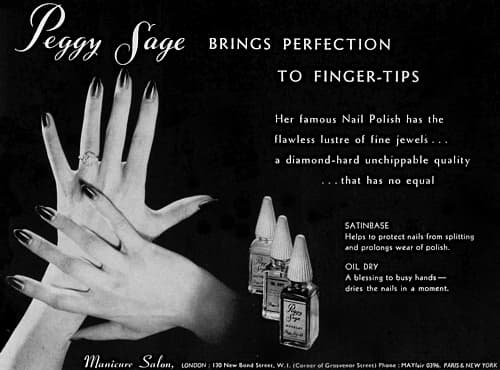
Above: 1951 Peggy Sage Satinbase and Oil-Dry (Britain).
Oil-Dry: “[T]o dry polish faster, and implements for a quick manicure on that grooming job to be done in a flash!”
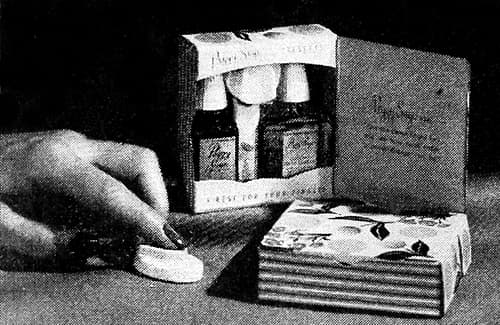
Above: 1949 Peggy Sage Finger Rest. Made from plastic it was used to hold the finger steady while the nail polish was applied.
In 1951, Peggy Sage added Finishing Cream to its other hand creams and lotions – Bouquet Hand Lotion, Gardenia Liquid Hand Cream, Hand Smoother and Softener Cream, Hand Whitener Cream, Hand Massage Cream, and Hand Mask Cream.
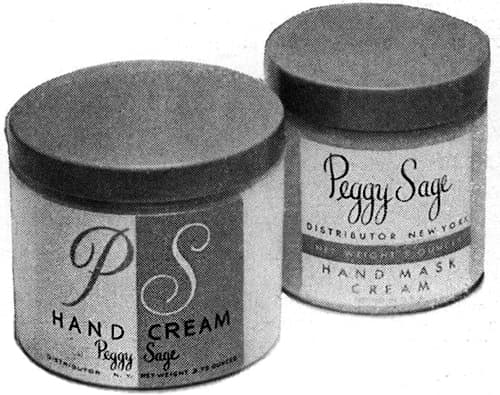
Above: 1949 Peggy Sage Hand Cream and Hand Mask Cream in new packaging.
The new pink-coloured Finishing Cream was recommended to be used after hand washing and as a hand protectant applied before going out.
Hand Finishing Cream: “[R]estores natural oils. Keeps hands soft and smooth.”
In 1951, Peggy Sage also added French Milled Soap in two scents, Sandalwood and Sweet Grass. Containing lanolin, this pink-coloured soap was moulded into a concave shape to better fit in the hand and help prevent the soap from sticking to surfaces. In 1952, Peggy Sage added Perfumed Spray Deodorant in a flexible squeeze bottle similar to that pioneered by Jules Montenier [1895-1962] in 1951.
See also: Stopette
Nail polish
New nail polish shades added between 1945 and 1950 included: Dark Knight, Sage Red, and Psyche Pink (1945); High Fashion, and Heady Wine (1946); Heartbreak Pink, and Raving Beauty (1947); Fashion Pink (1948); Dark Blaze (1949); and Peggy’s Own (1950).
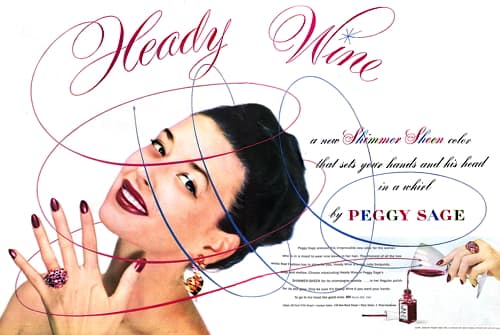
Above: 1946 Peggy Sage Heady Wine.
Additional Shimmer Sheen polishes included: Shimmering Dark Knight, Shimmering Sage Red, Shimmering Psyche Pink (1945); Shimmering Skyhigh, Shimmering High Fashion, Shimmering Bronze, and Shimmering Heady Wine (1946).
In 1951, Peggy Sage reformulated its Regular and Shimmer Sheen nail polishes to give them a ‘crystallin finish’. They were bottled in a taller, spill-proof container that could cater for the new long-handled brush, similar to the one Revlon introduced with Lastron Nail Enamel (1947).
Crystallin Finish Nail Polish: “A different method of color blending, a different technique of formulating the polish. A different, a very different, result! Gone forever any trace of muddiness, Instead, crystal-clear color, cool and clean as the waters of the Mediterranean . . . a finish that sparkles like the Empress'’ crown and, perhaps more important, possess the same Jewel-like hardness. Shrugs off day-in and night-out wear.” Clear, Cream, and Jewel Shades: Naturelle, Pale Cream, White Pearl, Gold, Bronze, Emerald Green, Blue Sapphire, Swampfire, Fireweed, Raving Beauty, Peggy’s Own, Flagship, Deep Claret, Heady Wine, Dusty Rose, Bisque, Sage Rose, Psyche Pink, Capri Coral, and Morocco. Shimmering Shades: Rose Pearl, Pink Pearl, Heartbreak Pink, Riviera, Fuschia, Psyche Pink, Dark Blaze, and Sequins.
Other products repackaged in 1951 were Peggy Sage Cuticle Remover, Manicure Oil, Nicotine Remover, Polishield, and Satin Base.
Lipsticks
In 1947, Peggy Sage launched Shimmer Lipsticks packaged in a gold-toned case in eight shades that were matched with Shimmer Sheen and Regular Nail Polishes. There are suggestions that the company made lipsticks in the early 1930s but if they did so the practice seemed to have lapsed.

Above: 1947 Peggy Sage Shimmer Lipsticks.
Shimmer Lipstick: “Sing Peggy Sage’s praises for creating Shimmer Lipstick! For the high-fashion colors . . . for its high lustre . . . its moisture . . . its amazing stay-on quality that will make your mouth water for this newest gift to fashion.” Shades: Heartbreak Pink, Psyche, Dark Fire, Victorian Rose, Skyhigh, Heady Wine, Fireweed, and High Fashion.
When longer ‘pencil’ lipsticks became fashionable in the late 1940s Peggy Sage added a second lipstick in a novel container. The Lipstick Convertible (1948) also came in a gold-toned metal case but was thinner and had a cap that could be fitted over the base to create a longer handle.
Lipstick Convertible: “[T]he best lipstick idea since lipstick itself. A beautifully designed, ingeniously designed case. Closed, it’s short and sweet, takes up practically no room in your new smaller handbags, or cosmetic cases. When you use it, you merely place the cap on the bottom. Presto long, graceful, easier to apply.” Shades: Heartbreak Pink, Raving Beauty, Psyche Pink, Fireweed, Dark Blaze, Skyhigh, and Heady Wine.
In 1951, when Peggy Sage introduced its Crystallin Finish Nail Polish it launched a new lipstick called Stay Sheen in another gold-toned case. As indelibles were then in fashion it was generally marketed as such.
Stay Sheen: “[T]he world’s smoothest, creamiest lipstick . . . so wondrously indelible it never smears. Lips stay fresh and soft as rose petals all day, all evening, with long lasting Stay Sheen! In a bevy of beautiful shades, all with harmonising Peggy Sage Nail Polish with Crystallin Finish.” Shades: Shades: Peggy’s Own, Raving Beauty, Victorian Rose, Fire Weed, Dark Blaze, and Heartbreak Pink.
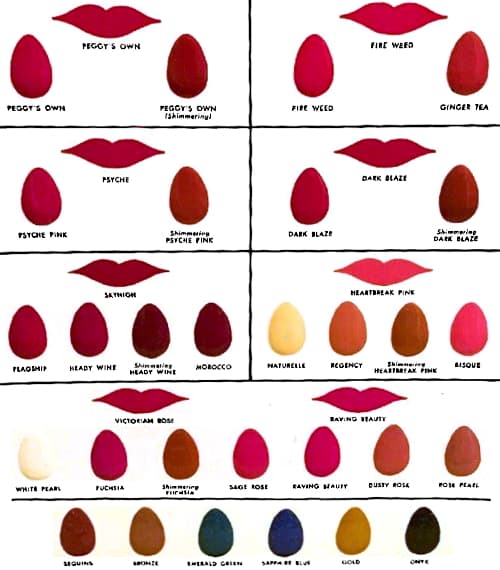
Above: c.1953 Peggy Sage Shade Chart.
New nail polish shades were added through the 1950s but there does not appear to have been a consistency between Europe and the United States so they are difficult to date.
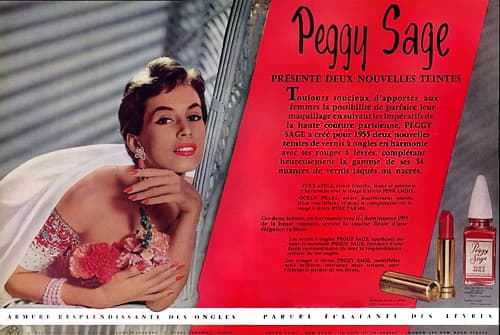
Above: 1954 Peggy Sage Lipstick and Nail Polish (France).
The chart below outlines French colours available in 1960 separated into Creme and Nachre (Pearl) shades matched with shades of lipstick. Unfortunately, the lipstick shades are only listed as numbers.
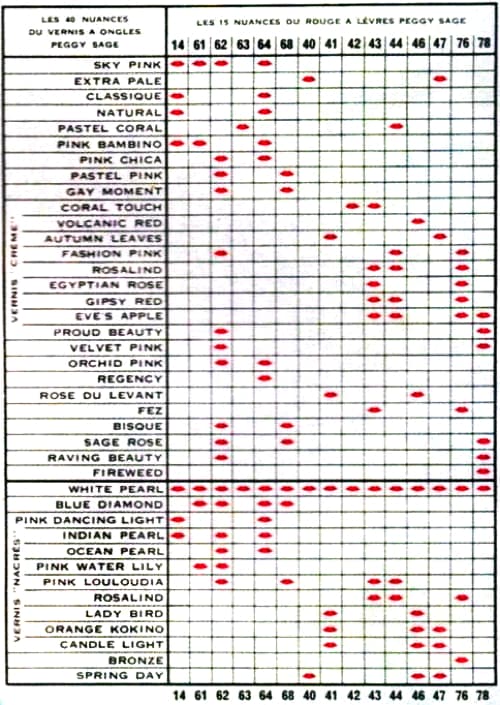
Above: 1960 Peggy Sage Shade Chart (France).
Other developments
In 1954, Mary Chess took over the distribution of Peggy Sage in the United States. This may have been done to reduce costs or to bolster the prestige of Peggy Sage by associating it with Mary Chess perfumes. Whatever the reason the arrangement did not proved to be satisfactory and Peggy Sage returned to distributing its own products in 1956. It also reduced their price for ‘wider distribution’ thereby cheapening the brand somewhat.
In 1960, Northam Warren sold out to Chesebrough-Pond’s and this included Peggy Sage. Chesebrough-Pond’s sold products chiefly through drug and variety stores so were not particularly interested in resurrecting Peggy Sage as a prestige brand and the range appears to have been reduced to nail polishes in the 1960s. I doubt that Chesebrough-Pond’s felt a pressing need to have a number of nail polish brands and may have only kept Peggy Sage due to its recognition in select markets such as France, Germany, and Brasil.
Unilever acquired Chesebrough-Pond’s in 1986 and seemed to show even less interest in the brand subsequently selling Peggy Sage to the Coulomb family in 1995. The new owners have concentrated on the European market and it was being retailed in France, Belgium and Switzerland when I last checked.
Timeline
| 1940 | New Products: Fingernail Gloves; and Mesh-Film Nail Polish. |
| 1944 | Building at 54 East 57th Street, New York acquired. Peggy Sage, Inc. established in Australia. New Products: Shimmer Sheen Nail Polish. |
| 1945 | New Products: Oil Dry. |
| 1947 | New Products: Shimmer Lipsticks. |
| 1948 | New Products: Lipstick Convertible. |
| 1951 | New Products: Crystallin Finish Nail Polish; Stay Sheen Lipsticks; Hand Finishing Cream; and French Milled Soap. |
| 1952 | New Products: Perfumed Spray Deodorant. |
| 1954 | Mary Chess assumes the distribution of Peggy Sage in the United States. Peggy Sage Corporation founded in New York. |
| 1956 | Peggy Sage takes over distribution from Mary Chess. |
| 1960 | Peggy Sage sold to Chesebrough-Pond’s. |
| 1986 | Chesebrough-Pond’s acquired by Unilever. |
| 1995 | Peggy Sage sold to the Coulomb family. |
First Posted: 6th April 2021
Last Update: 21st February 2024
Sources
The American perfumer & essential oil review. (1906-1955). New York: Robbins Perfumer Co. [etc.].
Federal Trade Commission (1942). Federal Trade Commission decisions: Findings, orders and stipulations (Vol 33). Washington: Government Printing Office.

Peggy Sage [1880-1961] a.k.a. Rosabelle Sage, Rosabelle Doody, and Rosella Doody.
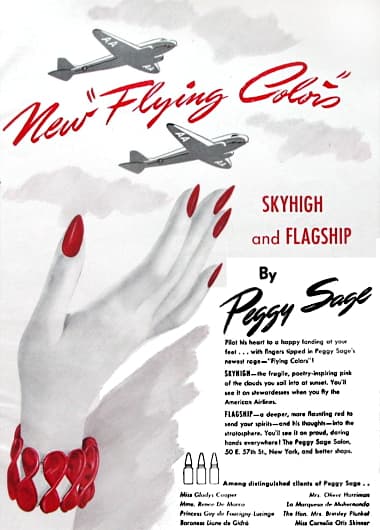
1940 Peggy Sage Skyhigh, and Flagship (Flying Colors).
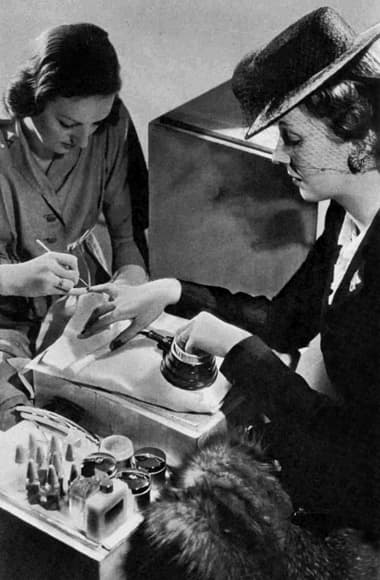
1940 Peggy Sage manicure in the London salon. The client is holding her left hand in electrically-warmed Nail-Flex oil, used to counteract nail brittleness, while the finishing touches to her nail polish are being completed on the other hand.
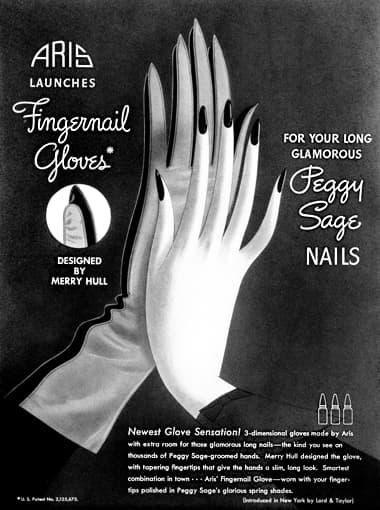
1940 Peggy Sage Fingernail Gloves. Made by Aris in suede in solid colours and two colour combinations. They were designed by Gladys Whitcomb Geissmann [1908-1978], better known as Merry Hull.

1940 Peggy Sage Mesh-Film Polish. Advertisements like this cease under orders from the FTC.
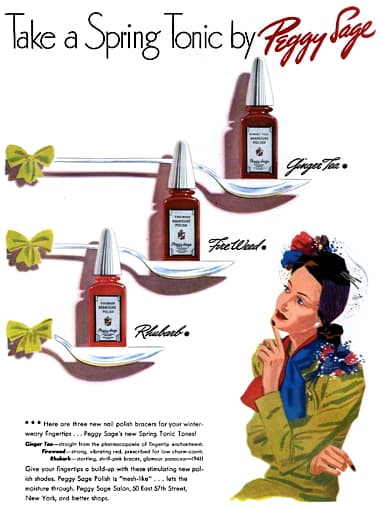
1941 Peggy Sage Rhubarb, Fire Weed and Ginger Tea.
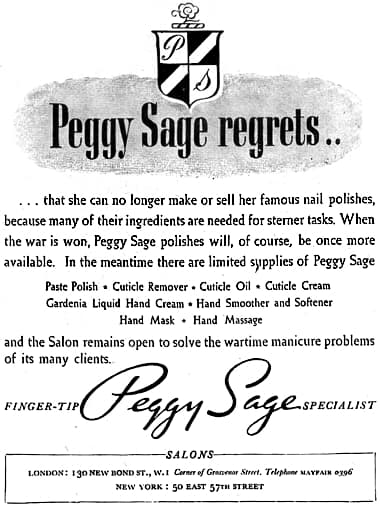
1945 Announcement that Peggy Sage nail polishes are no longer available in Britain.
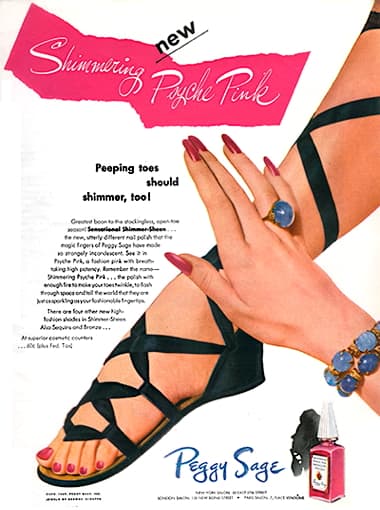
1945 Peggy Sage Shimmering Psyche Pink.
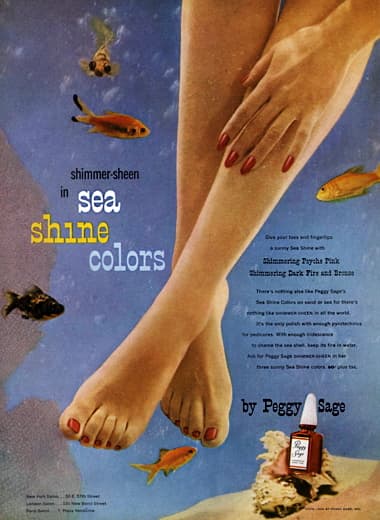
1946 Peggy Sage Sea Shine Colors – Shimmering Psyche Pink, Shimmering Dark Fire, and Shimmering Bronze.
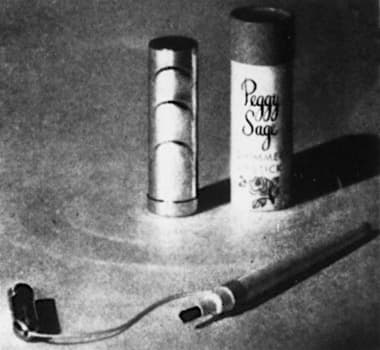
1947 Peggy Sage Shimmer Lipstick with packaging and Lipstick Brush.
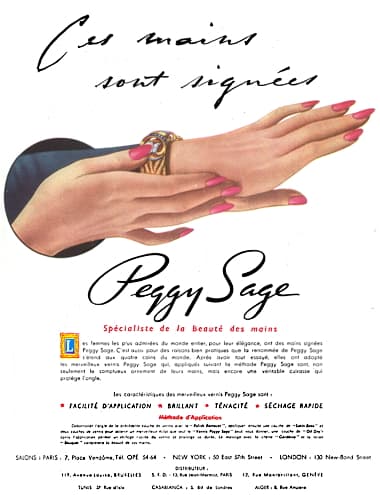
1948 Peggy Sage (France).
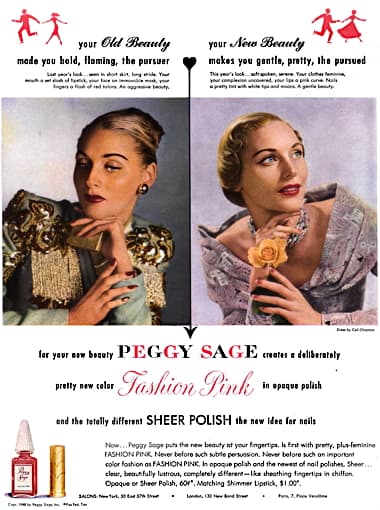
1948 Peggy Sage Fashion Pink.
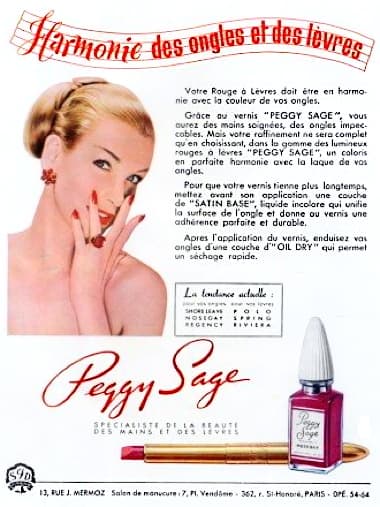
1951 Peggy Sage Nosegay Nail Polish and Lipstick Convertible (France).
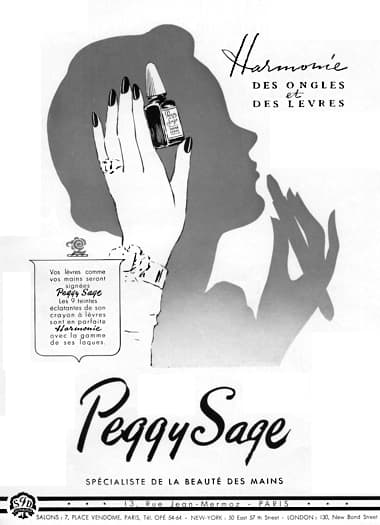
1950 Peggy Sage (France).

1952 Peggy Sage Proud Beauty.
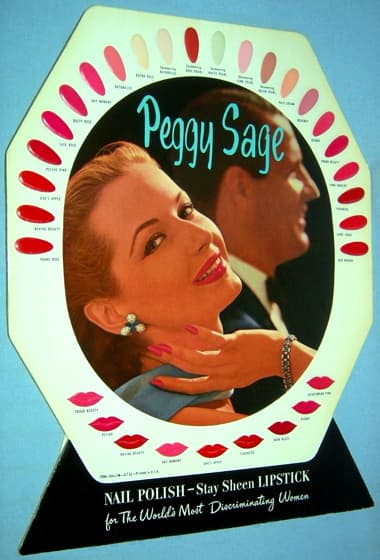
c.1955 Peggy Sage Shade Chart for Stay Sheen Lipsticks and Crystallin Finish Nail Polishes.
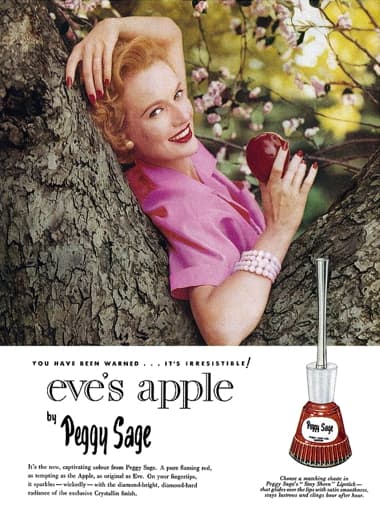
1955 Peggy Sage Eve’s Apple.

1958 Peggy Sage Party Rose.
